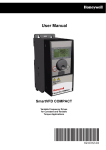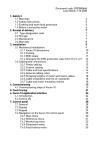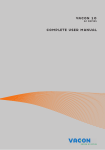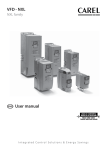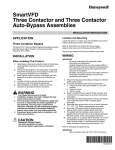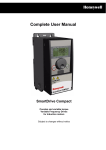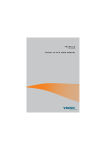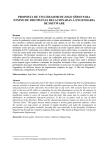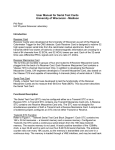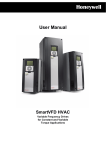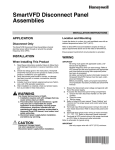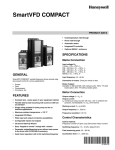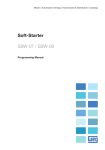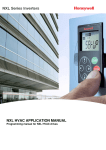Download User Manual - Cloudinary
Transcript
Ho 1 Honeywell Honeywell User Manual SmartVFD COMPACT Variable Frequency Drives for Constant and Variable Torque Applications By using this Honeywell literature, you agree that Honeywell will have no liability for any damages arising out of your use or modification to, the literature. You will defend and indemnify Honeywell, its affiliates and subsidiaries, from and against any liability, cost, or damages, including attorneys’ fees, arising out of, or resulting from, any modification to the literature by you. 62-0312—02 62-0312-01 62-0312—02 1 Honeywell User’s Manual Index 1. SAFETY ..........................................................................................3 1.1 Warnings ...............................................................................3 1.2 Safety instructions .................................................................5 1.3 Grounding and Ground fault protection .................................5 1.4 Before running the motor .......................................................6 2. RECEIPT OF DELIVERY ...............................................................7 2.1 Type designation code .........................................................7 2.2 Storage ..................................................................................8 2.3 Maintenance ..........................................................................8 2.4 Warranty ................................................................................8 3. TECHNICAL DATA ........................................................................9 3.1 Compact technical data ..........................................................9 3.2 Power ratings .........................................................................10 3.2.1 Compact - Mains voltage 208 - 240 V .........................10 3.2.2 Compact - Mains voltage 380 - 480 V .........................10 4. INSTALLATION ..............................................................................11 4.1 Mechanical installation ..........................................................11 4.1.1Compact dimensions ....................................................12 4.1.2 Cooling ........................................................................13 4.1.3 EMC levels ..................................................................13 4.1.4 Changing the EMC protection class from H or L to T ..14 4.2 Cabling and connections .......................................................15 4.2.1 Power cabling ..............................................................15 4.2.2 Control cabling ............................................................16 4.2.3 Cable and fuse specifications ......................................18 4.2.4 General cabling rules ..................................................19 4.2.5 Stripping lengths of motor and mains cables ..............20 4.2.6 Cable installation and the UL standards ......................20 4.2.7 Cable and motor insulation checks .............................20 5. COMMISSIONING ..........................................................................23 5.1 Commissioning steps of Compact ........................................23 6. FAULT TRACING ...........................................................................25 7. APPLICATION INTERFACE ..........................................................29 7.1 Introduction ............................................................................29 7.2 Control I/O .............................................................................31 8. CONTROL PANEL .........................................................................33 8.1 General ..................................................................................33 62-0312—02 Honeywell 2 8.2 Display ...................................................................................33 8.3 Keypad ..................................................................................34 8.4 Navigation on the Compact control panel ............................35 8.4.1 Main menu ..................................................................35 8.4.2 Reference menu .........................................................36 8.4.3 Monitoring menu .........................................................37 8.4.4 Parameter menu .........................................................39 8.4.5 Fault history menu ......................................................40 9. GENERAL PURPOSE APPLICATION PARAMETERS ................41 9.1 Quick setup parameters (Virtual menu, shows when par. 13.1 = 1) ..............................................................................................42 9.2 Motor settings (Control panel: Menu PAR -> P1) ..................44 9.3 Start/stop setup (Control panel: Menu PAR -> P2) ...............45 9.4 Frequency references (Control panel: Menu PAR -> P3) .....45 9.5 Ramps and brakes setup (Control panel: Menu PAR -> P4) 46 9.6 Digital inputs (Control panel: Menu PAR -> P5) ....................46 9.7 Analogue inputs (Control panel: Menu PAR -> P6) ...............48 9.8 Digital and analogue outputs (Control panel: Menu PAR -> P7) ..............................................................................................48 9.9 Protections (Control panel: Menu PAR -> P9) ......................49 9.10 Autorestart parameters (Control panel: Menu PAR -> P10 ) 50 9.11 PI control parameters (Control panel: Menu PAR -> P12) ..51 9.12 Easy usage menu (Control panel: Menu PAR -> P0) .........52 9.13 System parameters .............................................................52 10. PARAMETER DESCRIPTIONS ...................................................55 10.1 Motor settings (Control panel: Menu PAR -> P1) ................55 10.2 Start/Stop setup (Control panel: Menu PAR -> P2) .............58 10.3 Frequency references (Control panel: Menu PAR -> P3) ...60 10.4 Ramps & brakes setup (Control panel: Menu PAR -> P4) ..60 10.5 Digital inputs (Control panel: Menu PAR -> P5) ..................63 10.6 Analoque inputs (Control panel: Menu PAR -> P6) .............64 10.7 Digital and analoque outputs (Control panel: Menu PAR -> P7) ..............................................................................................64 10.8 Motor thermal protection (parameters 9.7 - 9.10) ................65 10.9 Autorestart parameters (Control panel: Menu PAR -> P10) 67 10.10 PI control parameters (Control panel: Menu PAR -> P12) 68 10.11 Easy usage menu (Control panel: Menu PAR -> P9) ........69 10.12 Fieldbus parameters (Control panel: Menu PAR -> S2) ....71 10.12.1 Modbus process data ..............................................72 62-0312—02 1 3 Safety Honeywell 1. SAFETY ONLY A COMPETENT ELECTRICIAN IS ALLOWED TO CARRY OUT THE ELECTRICAL INSTALLATION! This manual contains clearly marked cautions and warnings which are intended for your personal safety and to avoid any unintentional damage to the product or connected appliances. Please read the information included in cautions and warnings carefully: = Dangerous voltage Risk of death or severe injury = General warning Risk of damage to the product or connected appliances 1.1 WARNINGS 1 2 3 4 5 The components of the power unit of the frequency converter are live when the VFD is connected to mains potential. Coming into contact with this voltage is extremely dangerous and may cause death or severe injury. The control unit is isolated from the mains potential. The motor terminals U, V, W (T1, T2, T3) and the possible brake resistor terminals -/+ are live when VFD is connected to mains, even if the motor is not running. The control I/O-terminals are isolated from the mains potential. However, the relay output terminals may have a dangerous control voltage present even when VFD is disconnected from mains. The ground leakage current of the variable frequency drive exceeds 3.5mA AC. According to standard EN618005-1, a reinforced protective ground connection must be ensured. If the frequency converter is used as a part of a machine, the machine manufacturer is responsible for providing the machine with a main switch (EN 60204-1). 62-0312—02 Safety Honeywell 6 7 62-0312—02 4 If the VFD is disconnected from mains while running the motor, it remains live if the motor is energized by the process. In this case the motor functions as a generator feeding energy to the frequency converter. After disconnecting the frequency converter from the mains, wait until the fan stops and the indicators on the display go out. Wait 5 more minutes before doing any work on the VFD connections. 1 1 5 Safety Honeywell 1.2 SAFETY INSTRUCTIONS 1 The variable frequency drive has been designed for fixed installations only. 2 Do not perform any measurements when the frequency converter is connected to the mains. 3 Do not perform any voltage withstand tests on any part of the VFD. The product safety is fully tested at factory. 4 Prior to measurements on the motor or the motor cable, disconnect the motor cable from the frequency converter. 5 Do not open the cover of VFD. Static voltage discharge from your fingers may damage the components. Opening the cover may also damage the device. If the cover of the VFD is opened, warranty becomes void. 1.3 GROUNDING AND GROUND FAULT PROTECTION The Compact VFD must always be grounded with an grounding conductor connected to the grounding terminal. See figure below: • The ground fault protection inside the frequency converter protects only the converter itself against ground faults. • If fault current protective switches are used they must be tested with the drive with ground fault currents that are possible to arise in fault situations. 62-0312—02 Honeywell Safety 1.4 BEFORE RUNNING THE MOTOR Checklist: Before starting the motor, check that the motor is mounted properly and ensure that the machine connected to the motor allows the motor to be started. Set the maximum motor speed (frequency) according to the motor and the machine connected to it. Before reversing the motor shaft rotation direction make sure that this can be done safely. Make sure that no power correction capacitors are connected to the motor cable. 62-0312—02 6 1 7 Receipt of Delivery Honeywell 2. RECEIPT OF DELIVERY After unpacking the product, check that no signs of transport damages are to be found on the product and that the delivery is complete (compare the type designation of the product to the code below). Should the drive have been damaged during the shipping, please contact primarily the cargo insurance company or the carrier. If the delivery does not correspond to your order, contact the supplier immediately. 2.1 TYPE DESIGNATION CODE Figure 2.1: Type Code Designation 2 62-0312—02 Honeywell Receipt of Delivery 8 2.2 STORAGE If the frequency converter is to be kept in store before use make sure that the ambient conditions are acceptable: Storing temperature -40 °F(-40 °C)…+70 °F(21 °C) Relative humidity < 95%, no condensation 2.3 MAINTENANCE In normal operating conditions, Compact VFD are maintenance-free. 2.4 WARRANTY Only manufacturing defects are covered by the warranty. The manufacturer assumes no responsibility for damages caused during or resulting from transport, receipt of the delivery, installation, commissioning or use. The manufacturer shall in no event and under no circumstances be held responsible for damages and failures resulting from misuse, wrong installation, unacceptable ambient temperature, dust, corrosive substances or operation outside the rated specifications. Neither can the manufacturer be held responsible for consequential damages. Variable frequency drive devices (VFD) and accessories: new products for thiry-six (36) months and factory refurbished drives for twelve (12) months from date of installation when start-up and commissioning is performed by Honeywell VFD Authorized and trained personnel. All VFD warranty return products must have priorauthorization (Form No. 87-0284) and be returned only to the VFD Service Center in Chattanooga, TN. 62-0312—02 2 3 9 Technical Data Honeywell 3. TECHNICAL DATA 3.1 COMPACT TECHNICAL DATA Frame Dimensions and weight EMC D (in) Weight (lb) Output voltage 0 - Uin Output current Continuous rated current IN at ambient temperature max. 122 ºF (+50 ºC), overload 1.5 x IN max. 1min/10min 14 °F (-10 °C) (no frost)…122 °F (+50 °C): rated loadability IN Ambient operating temperature Ambient conditions W (in) 6.1 2.6 3.9 1.2 7.7 3.5 4.0 1.5 10.3 3.9 4.3 2.18 Compact (400V) cannot be used with corner grounded networks Supply network Motor connection H (in) MI1 MI2 MI3 Storage temperature -40 °F (-40 °C)…+158 °F (+70 °C) Relative humidity 0…95% RH, non-condensing, non-corrosive, no dripping water Altitude 100% load capacity (no derating) up to 3280 ft. 1% derating for each 328 ft above 3280 ft; max. 6560 ft Enclosure class IP20 (open Chassis), option: NEMA 1 Immunity Complies with EN50082-1, -2, EN61800-3 Emissions 230V : Complies with EMC category C2 (Honeywell level H); With an internal RFI filter 400V: Complies with EMC category C2 (Honeywell level H): With an internal RFI filter Both: No EMC emission protection (Honeywell level N): Without RFI filter Standards Certificates and manufacturer’s declarations of conformity For EMC: EN61800-3, For safety: UL508C, EN61800-5-1 For safety: CB, CE, UL, cUL, For EMC: CE, CB, c-tick (see unit nameplate for more detailed approvals) Table 3.1 : Technical data 62-0312—02 Technical Data Honeywell 10 3.2 POWER RATINGS 3.2.1 Mains voltage 208 - 240 V Mains voltage 208-240 V, 50/60 Hz, 1~ series Product code HVFDCD1B0003xxx HVFDCD1B0005xxx HVFDCD1B0007xxx HVFDCD1B0010xxx HVFDCD1B0015xxx HVFDCD1B0020xxx HVFDCD1B0030xxx Rated loadability 100% contin. current IN [ A ] 150% overload current [ A ] Motor shaft power P [ HP ] 1.7 2.4 2.8 3.7 4.8 7.0 9.6 2.6 3.6 4.2 5.6 7.2 10.5 14.4 0.25 0.5 0.75 1 1.5 2 3 Nominal input current [A] Mechanical size and weight (lb) 4.2 5.7 6.6 8.3 11.2 14.1 15.8 MI1 1.2 MI1 1.2 MI1 1.2 MI1 1.2 MI2 1.5 MI2 1.5 MI3, 2.18 Table 3.2 : Power ratings, 208 - 240 V 3.2.2 Mains voltage 380 - 480 V Mains voltage 380-480 V, 50/60 Hz, 3~ series Product code HVFDCD3C0005xxx HVFDCD3C0007xxx HVFDCD3C0010xxx HVFDCD3C0015xxx HVFDCD3C0020xxx HVFDCD3C0030xxx HVFDCD3C0040xxx HVFDCD3C0050xxx HVFDCD3C0075xxx Rated loadability Motor shaft power 100% continuous current IN [ A ] 150% overload current [A] 380-480V supply P[ HP ] 1.3 1.9 2.4 3.3 4.3 5.6 7.6 9.0 12.0 2.0 2.9 3.6 5.0 6.5 8.4 11.4 13.5 18.0 0.5 0.75 1 1.5 2 3 4 5 7.5 Nomina Mechanical l input size and current weight (lb) [A] 2.2 2.8 3.2 4.0 5.6 7.3 9.6 11.5 14.9 MI1 1.2 MI1 1.2 MI1 1.2 MI1 1.2 MI2 1.5 MI2 1.5 MI3, 2.18 MI3, 2.18 MI3, 2.18 Table 3.3 : Power ratings, 380 - 480 V Note 1: The input currents are calculated values with 100 kVA line transformer supply. Note 2: The mechanical dimensions of the units are given in Chapter 4.1.1. 62-0312—02 3 11 Installation Honeywell 4. INSTALLATION 4.1 MECHANICAL INSTALLATION There are two possible ways to mount the Compact VFD to the wall - either screw or DIN-rail mounting. The mounting dimensions are given on the back of the drive and on the following page. MI1 MI2-3 =M 5 =M 4 Figure 4.1: Screw mounting 1 2 Figure 4.2: DIN-rail mounting 4 62-0312—02 Installation Honeywell 12 4.1.1 Dimensions W2 D2 W3 H1 H2 H3 Honeywell D1 W1 Figure 4.3: Dimensions, MI1-MI3 Type H1 H2 H3 W1 W2 W3 D1 D2 MI1 MI2 MI3 6.2 7.7 10.3 5.8 7.2 9.9 5.4 6.7 9.5 2.6 3.5 3.9 1.5 2.5 3.0 0.2 0.2 0.2 3.9 4 4.3 0.3 0.3 0.3 Table 4.1 : Dimensions in inches 62-0312—02 4 13 Installation Honeywell 4.1.2 Cooling Forced air flow cooling is used in all Compact VFDs. Enough free space must be left above and below the frequency converter to ensure sufficient air circulation and cooling. The required dimensions for free space are given in the table below: Type MI1 MI2 MI3 Dimensions (inch) A 3.9 3.9 3.9 A B 2.0 2.0 2.0 Table 4.2 : Dimensions required for cooling Type Cooling air required (CFM) MI1 MI2 MI3 5.89 5.89 17.7 Honeywell B Table 4.3 : Required cooling air mk6.fh11 4.1.3 EMC levels Compact frequency converters are divided into five classes according to the level of electromagnetic disturbances emitted, the requirements of a power system network and the installation environment (see below). The EMC class of each product is defined in the type designation code. Category C1: Frequency converters of this class comply with the requirements of category C1 of the product standard EN 61800-3 (2004). Category C1 ensures the best EMC characteristics and it includes converters the rated voltage of which is less than 1000V and which are intended for use in the 1st environment. NOTE: The requirements of class C are fulfilled only as far as the conducted emissions are concerned. Category C2: Frequency converters of this class comply with the requirements of category C2 of the product standard EN 61800-3 (2004). Category C2 includes converters in fixed installations and the rated voltage of which is less than 1000V. The class H frequency converters can be used both in the 1st and the 2nd environment. Category C3: Frequency converters of this class comply with the requirements of category C3 of the product standard EN 61800-3 (2004). Cateory C3 includes converters the rated voltage of which is less than 1000V and which are intended for use in the second environment only. 4 62-0312—02 Honeywell Installation 14 Category C4: The drives of this class do not provide EMC emission protection. These kinds of drives are mounted in enclosures. NOTE: An external EMC filter is usually required to fulfil the EMC emission requirements. Category C4 for IT networks: Frequency converters of this class fulfil the product standard EN 61800-3 (2004) if intended to be used in IT systems. In IT systems, the networks are isolated from ground, or connected to ground through high impedance to achieve a low leakage current. NOTE: if converters are used with other supplies, no EMC requirements are complied with. Environments in product standard EN 61800-3 (2004) First environment: Environment that includes domestic premises. It also includes establishments directly connected without intermediate transformers to a low-voltage power supply network which supplies buildings used for domestic purposes. NOTE: houses, apartments, commercial premises or offices in a residential building are examples of first environment locations. Second environment: Environment that includes all establishments other than those directly connected to a low-voltage power supply network which supplies buildings used for domestic purposes. NOTE: industrial areas, technical areas of any building fed from a dedicated transformer are examples of second environment locations. 4.1.4 Changing the EMC protection class from H or L to T The EMC protection class of Compact frequency converters can be changed from class H or L to class T by removing the EMC-capacitor disconnecting screw, see figure below. Note! Do not attempt to change the EMC level back to class H or L. Even if the procedure above is reversed, the frequency converter will no longer fulfil the EMC requirements of class H/L! 62-0312—02 4 15 Installation Honeywell 4.2 CABLING AND CONNECTIONS 4.2.1 Power cabling Note! Tightening torque for power cables is 4 - 5 in-lbs. 3~ (400V) Motor out 1~ (230V) Strip the plastic cable coating for 360° grounding MOTOR MAINS Figure 4.4: Power connections, MI1 3~ (400V) 1~ (230V) External brake resistor (400V) Motor out L1 L2/N L3 R+ R- U/T1 V/T2 W/T3 Strip the plastic cable coating for 360° grounding MAINS BRAKE RESISTOR MOTOR Figure 4.5: Power connections, MI2 - MI3 4 62-0312—02 Installation Honeywell 16 4.2.2 Control cabling Attach the support AFTER installing the power cables Honeywell Attach this plate BEFORE installing the power cables Figure 4.6: Mount the PE- plate and API cable support 62-0312—02 4 17 Installation Honeywell Figure 4.7: Open the cover Control cable tightening torque: 3 in-lbs Strip the plastic cable coating for 360° grounding Figure 4.8: Install the control cables. See Chapter 7.2 4 62-0312—02 Installation Honeywell 18 4.2.3 Cable and fuse specifications Use cables with heat resistance of at least 158 °F (+70 °C). The cables and the fuses must be sized according to the tables below. Installation of cables according to UL regulations is presented in Chapter 4.2.6. The fuses also function as cable overload protection. These instructions apply only to cases with one motor and one cable connection from the frequency converter to the motor. In any other case, ask the factory for more information. EMC class Mains cable types Motor cable types Control cable types Level H 1 3 4 Level L 1 2 4 Level N 1 1 4 Table 4.4 : Cable types required to meet standards. EMC levels are described in Chapter 4.1.3. Cable type Description 1 Power cable intended for fixed installation and the specific mains voltage. Shielded cable not required. (NKCABLES/MCMK or similar recommended) 2 Power cable equipped with concentric protection wire and intended for the specific mains voltage. (NKCABLES /MCMK or similar recommended). 3 Power cable equipped with compact low-impedance shield and intended for the specific mains voltage. (NKCABLES /MCCMK, SAB/ÖZCUY-J or similar recommended). *360º grounding of both motor and FC connection required to meet the standard 4 Screened cable equipped with compact low-impedance shield (NKCABLES /Jamak, SAB/ÖZCuY-O or similar). Table 4.5 : Cable type descriptions Frame MI1 MI2 MI3 Type IN [A] P25 - P75 1,7-3,7 1P1 - 1P5 4,8-7,0 2P2 11 Terminal cable size (min/max) Fus Mains cable Main Ground Control Relay e Cu [AWG] terminal terminal terminal terminal [A] 10 20 32 2*15+15 2*13+13 2*9+9 [AWG] [AWG] [AWG] [AWG] 15-11 15-11 15-9 15-11 15-11 15-9 20-15 20-15 20-15 20-15 20-15 20-15 Table 4.6 : Cable and fuse sizes for 208 - 240V 62-0312—02 4 19 Installation Frame Type IN [A] Fuse [A] MI1 MI2 MI3 P37 - 1P1 1P5 - 2P2 3P0 - 5P5 1,9-3,3 4,3-5,6 7,6 - 12 6 10 20 Honeywell Terminal cable size (min/max) Mains Main Ground Control Relay cable Cu [AWG] terminal terminal terminal terminal 3*15+15 3*15+15 3*13+13 [AWG] [AWG] [AWG] [AWG] 15-11 15-11 15-9 15-11 15-11 15-9 20-15 20-15 20-15 20-15 20-15 20-15 Table 4.7 : Cable and fuse sizes for 380 - 480V Note! To fulfil standard EN61800-5-1, the protective conductor should be at least AWG 7 Cu or AWG 5 Al. Another possibility is to use an additional protective conductor of at least the same size as the original one. 4.2.4 General cabling rules 4 1 Before starting the installation, check that none of the components of the frequency converter is live. 2 Place the motor cables sufficiently far from other cables: • Avoid placing the motor cables in long parallel lines with other cables • If the motor cable runs in parallel with other cables, the minimum distance between the motor cable and other cables is 11.8 inches. • The given distance also applies between the motor cables and signal cables of other systems. • The maximum length of the motor cables is 100 feet. • The motor cables should cross other cables at an angle of 90 degrees. 3 If cable insulation checks are needed, see Chapter 4.2.7. 4 Connecting the cables: • Strip the motor and mains cables as advised in Figure 4.9. • Connect the mains, motor and control cables into their respective terminals, see Figures 4.4 - 4.8. • Note the tightening torques of power cables and control cables given in page 15 and page 17. • For information on cable installation according to UL regulations see Chapter 4.2.6 . • Make sure that the control cable wires do not come in contact with the electronic components of the unit • If an external brake resistor (option) is used, connect its cable to the appropriate terminal. • Check the connection of the ground cable to the motor and the frequency converter terminals marked with • Connect the separate shield of the motor cable to the ground plate of the frequency converter, motor and the supply centre 62-0312—02 Installation Honeywell 20 4.2.5 Stripping lengths of motor and mains cables Ground conductor 0.3 in 0.3 in 1.4 in 0.8 in Figure 4.9: Stripping of cables Note! Strip also the plastic cover of the cables for 360 degree grounding. See Figures 4.4, 4.5 and 4.8. 4.2.6 Cable installation and the UL standards To meet the UL (Underwriters Laboratories) regulations, a UL-approved copper cable with a minimum heat-resistance of 140/167 °F (+60/75 °C) must be used. 4.2.7 Cable and motor insulation checks These checks can be performed as follows if motor or cable insulations are suspected to be faulty. 1. Motor cable insulation checks Disconnect the motor cable from terminals U/T1, V/T2 and W/T3 of the frequency converter and from the motor. Measure the insulation resistance of the motor cable between each phase conductor as well as between each phase conductor and the protective ground conductor. The insulation resistance must be >1MOhm. 2. Mains cable insulation checks Disconnect the mains cable from terminals L1, L2/N and L3 of the frequency converter and from the mains. Measure the insulation resistance of the mains cable between each phase conductor as well as between each phase conductor and the protective ground conductor.The insulation resistance must be >1MOhm. 3. Motor insulation checks 62-0312—02 4 21 Installation Honeywell Disconnect the motor cable from the motor and open the bridging connections in the motor connection box. Measure the insulation resistance of each motor winding. The measurement voltage must equal at least the motor nominal voltage but not exceed 1000 V. The insulation resistance must be >1MOhm. 4 62-0312—02 Honeywell 62-0312—02 Installation 22 4 5 23 Commissioning Honeywell 5. COMMISSIONING Before commissioning, note the warnings and instructions listed in Chapter 1! 5.1 COMMISSIONING STEPS 1 2 Read carefully the safety instructions in Chapter 1 and follow them. After the installation, make sure that: • both the frequency converter and the motor are grounded • the mains and motor cables comply with the requirements given in Chapter 4.2.3 • the control cables are located as far as possible from the power cables (see Chapter , step 2) and the shields of the shielded cables are connected to protective ground 3 Check the quality and quantity of cooling air (Chapter 4.1.2) 4 Check that all Start/Stop switches connected to the I/O terminals are in Stop-position. 5 Connect the frequency converter to mains Note: The following steps are valid if you have API Full or API Limited Application Interface. 6 Set the parameters of group 1 according to the requirements of your application. At least the following parameters should be set: • motor nominal voltage (par. 1.1) • motor nominal frequency (par. 1.2) • motor nominal speed (par. 1.3) • motor nominal current (par. 1.4) You will find the values needed for the parameters on the motor rating plate 62-0312—02 Honeywell Commissioning 24 Perform test run without motor. Perform either Test A or Test B: 7 A) Control from the I/O terminals: • Turn the Start/Stop switch to ON position. • Change the frequency reference (potentiometer) • Check in the Monitoring Menu that the value of Output frequency changes according to the change of frequency reference. • Turn the Start/Stop switch to OFF position B) Control from the keypad: • Select the keypad as the control place with par. 2.1. You can also move to keypad control by pressing the navigation wheel for 5 seconds. • Push the Start button on the keypad • Check in the Monitoring Menu that the value of Output frequency changes according to the change of frequency reference • Push the Stop button on the keypad 8 Run the no-load tests without the motor being connected to the process, if possible. If this is not possible, secure the safety of each test prior to running it. Inform your co-workers of the tests. • Switch off the supply voltage and wait up until the drive has stopped. • Connect the motor cable to the motor and to the motor cable terminals of the frequency converter. • See to that all Start/Stop switches are in Stop positions. • Switch the mains ON • Repeat test 7A or 7B 9 Connect the motor to the process (if the no-load test was run without the motor being connected) • Before running the tests, make sure that this can be done safely. • Inform your co-workers of the tests. • Repeat test 7A or 7B. 62-0312—02 5 25 Fault Tracing Honeywell 6. FAULT TRACING Note: The fault codes listed in this chapter are visible if the Application Interface has a display, like e.g. in API FULL or API LIMITED or if a personal computer has been connected to the drive When a fault is detected by the frequency converter control electronics, the drive is stopped and the symbol F together with the ordinal number of the fault and the fault code appear on the display in the following format, e.g: F1 02 Fault code (02 = overvoltage) Fault ordinal number (F1 = latest fault) The fault can be reset by pressing the Stop button on the control keypad or via the I/ O terminal or fieldbus. The faults with time labels are stored in the Fault history menu which can be browsed. The different fault codes, their causes and correcting actions are presented in the table below. Fault code 1 2 3 Fault name Possible cause Correcting actions Overcurrent Frequency converter has detected too high a current (>4*IN) in the motor cable: • sudden heavy load increase • short circuit in motor cables • unsuitable motor Overvoltage The DC-link voltage has exceeded the internal safety limit: Increase the deceleration • too short a deceleration time time (P.4.3) • high overvoltage spikes in mains Ground fault Current measurement has detected extra leakage current at Check motor cables and start: motor • insulation failure in cables or motor Check loading. Check motor size. Check cables. Table 6.1 : Fault codes 6 62-0312—02 Honeywell Fault code Fault name 8 System fault Fault Tracing Possible cause • component failure • faulty operation 26 Correcting actions Reset the fault and restart. Should the fault re-occur, contact the distributor near to you The DC-link voltage has exceeded the internal safety limit: • most probable cause: too low a supply voltage • frequency converter internal fault • Power outages In case of temporary supply voltage break reset the fault and restart the frequency converter. Check the supply voltage. If it is adequate, an internal failure has occurred. Contact the distributor near to you Frequency converter undertemperature IGBT switch temperature is under 14 °F(-10 °C) Check the ambient temperature 14 Frequency converter overtemperature IGBT switch temperature is over 248 °F (120 °C). Overtemperature warning is issued when the IGBT switch temperature exceeds 230 °F (110 °C). Check that the cooling air flow is not blocked. Check the ambient temperature. Make sure that the switching frequency is not too high in relation to ambient temperature and motor load. 15 Motor stalled Motor stall protection has tripped Check motor 16 Motor overtemperature Motor overheating has been Decrease the motor load. detected by frequency converter If no motor overload motor temperature model. Motor exists, check the temperis overloaded ature model parameters. 22 EEPROM checksum fault Parameter save fault • faulty operation • component failure 25 Microcontroller watchdog fault 34 Internal bus communication 9 13 Undervoltage • faulty operation • component failure Contact the distributor near to you Reset the fault and restart. Should the fault re-occur, contact the distributor near to you. Should the fault re-occur, Ambient interference or defective contact the distributor hardware near to you. Table 6.1 : Fault codes 62-0312—02 6 27 Fault code Fault Tracing Fault name Possible cause 35 Application fault Application does not function 50 Analogue input Iin < 4mA (selected signal range 4 to 20 mA) Current at the analogue input is < 4mA • control cable is broken or loose • signal source has failed 51 External fault 53 Fieldbus fault Digital input fault. Digital input has been programmed as external fault input and this input is active. Honeywell Correcting actions Contact the distributor near to you Check the current loop circuitry Check the programming and the device indicated by the external fault information. Check also the cabling of this device. Check installation. The data connection between If installation is correct the fieldbus Master and the fieldcontact the nearest Honbus of the drive broken eywell distributor. Table 6.1 : Fault codes 6 62-0312—02 Honeywell 62-0312—02 Fault Tracing 28 6 7 29 API Honeywell 7. APPLICATION INTERFACE 7.1 INTRODUCTION There are three versions of Application Interfaces (API) available: : API Full API Limited API RS-485 (Modbus RTU) 6 Digital inputs 3 Digital inputs 1 Digital input 2 Analogue inputs 1 Analogue input 1 Relay output 1 Analogue output 1 Relay output RS-485 Interface 1 Digital output RS-485 Interface 2 Relay outputs RS-485 Interface Table 7.1 : Available Application Interfaces This section provides you with a description of the I/O-signals for these versions and instructions for using the general purpose application. The frequency reference can be selected from the analogue inputs, fieldbus, preset speeds or keypad. Basic properties: • Digital inputs DI1…DI6 are freely programmable. The user can assign a single input to many functions • Digital-, relay- and analogue outputs are freely programmable • Analogue input 1 can be programmed as current or voltage input in API Limited version Special features in all API versions: • Programmable Start/Stop and Reverse signal logic • Reference scaling • Programmable start and stop functions • DC-brake at start and stop • Programmable U/f curve • Adjustable switching frequency • Autorestart function after fault • Protections and supervisions (all fully programmable; off, warning, fault): 62-0312—02 Honeywell API • Current signal input fault • External fault • Undervoltage fault • Ground fault • Motor thermal, stall and underload protection • Fieldbus communication Special features in API Full and API Limited: • 8 preset speeds • Analogue input range selection, signal scaling and filtering • PI-controller 62-0312—02 30 7 7 31 API 7.2 CONTROL I/O Honeywell API FULL Signal Terminal 1 +10Vre Ref. voltage out Analog signal in 1 2 AI1 Factory preset Freq. reference P) Description Maximum load 10 mA 0 - +10 V Ri = 200 k Ω (min) 3 6 GND 24Vout I/O signal ground 24V output for DI's ± 20 %, max. load 50 mA mA 7 8 GND DI1 I/O signal ground Digital input 1 Start forward P) 9 10 A B 4 DI2 Digital input 2 Start reverse P) DI3 Digital input 3 A B AI2 RS485 signal A RS485 signal B Analog signal in 2 Preset speed B0 P) FB Communication FB Communication PI actual value P) 0(4) - 20 mA, Ri = 200 5 13 14 15 16 18 GND GND DI4 I/O signal ground I/O signal ground Digital input 4 Preset speed B1P) 0 - +30 V Ri = 12 k DI5 Digital input 5 Fault reset P) DI6 Digital input 6 Disable PI contr. P) AO 20 DO 22 RO 11 23 RO 12 24 RO 21 25 RO 22 26 RO 23 Output frequency P) Digital signal out Relay out 1 Active = READY P) Active = RUN P) Relay out 2 Active = FAULT P) Ω 0 - +30 V Ri = 12 k min Ω Ω (min) Ω 0(4) - 20 mA, RL = 500 Open collector, max. load 48V/50mA Max. switching load: 250Vac/2A or 250Vdc/ 0.4A Max. switching load: 250Vac/2A or 250Vdc/ 0.4A Table 7.2 : General purpose application default I/O configuration and connections for API FULL version P) = Programmable function, see parameter lists and descriptions, chapters 9 and 10. 62-0312—02 API Honeywell 32 API LIMITED Signal Terminal 1 +10Vre Ref. voltage out Analog signal in 1 2 AI1 3 6 GND 24Vout Factory preset Freq. reference P) I/O signal ground 24V output for DI's Description Maximum load 10 mA 0 - +10 V Ri = 200 k Ω ± 20 %, max. load 50 mA 7 8 GND DI1 I/O signal ground Digital input 1 Start forward P) 9 10 A B 24 25 DI2 Digital input 2 Start reverse P) DI3 Digital input 3 A B RO 21 RO 22 RS485 signal A RS485 signal B Relay out 2 Preset speed B0 P) FB Communication FB Communication ACTIVE (Relay opened) = FAULT P) Ω 0 - +30 V Ri = 12 k min Max. switching load: 250Vac/2A or 250Vdc/ 0.4A Table 7.3 : General purpose application default I/O configuration and connections for API LIMITED version P) = Programmable function, parameter lists and descriptions, chapters 9 and 10. API RS-485 Terminal 3 GND 6 24Vout Signal I/O signal ground 24V output for DI's Factory preset Description ± 20 %, max. load 50 mA 7 8 GND DI1 I/O signal ground Digital input 1 A B 24 25 A B RO 21 RO 22 RS485 signal A RS485 signal B Relay out 2 1 = Start forward FB Communication FB Communication ACTIVE (Relay opened) = FAULT P) Ω 0 - +30 V Ri = 12 k min Max. switching load: 250Vac/2A or 250Vdc/ 0.4A Table 7.4 : General purpose application default I/O configuration and connections for API RS-485 version P) = Programmable function, parameter lists and descriptions, chapters 9 and 10. 62-0312—02 7 33 Control Panel Honeywell 8. CONTROL PANEL 8.1 GENERAL The API Full and API Limited versions have similar control panels. The panel is integrated to the drive consisting of corresponding application card and an overlay on the drive cover with status display and button clarifications. The Control panel consists of an LCD display with backlight and a keypad including a navigation wheel, a green START button and a red STOP button (see Figure 8.1). 8.2 DISPLAY The display includes 14-segment and 7-segment blocks, arrowheads and clear text unit symbols. The arrowheads, when visible, indicate some information about the drive, which is printed in clear text on the overlay (numbers 1…14 in the figure below). The arrowheads are grouped in 3 groups with the following meanings and English overlay texts (see Figure 8.1): Group 1 - 5; Drive status 1= Drive is ready to start (READY) 2= Drive is running (RUN) 3= Drive has stopped (STOP) 4= Alarm condition is active (ALARM) 5= Drive has stopped due to a fault (FAULT) Group 6 - 10; Control selections 6= Motor is rotating forward (FWD) 7= Motor is rotating reverse (REV) 8= I/O terminal block is the selected control place (I/O) 9= Keypad is the selected control place (KEYPAD) 10= Fieldbus is the selected control place (BUS) Group 11 - 14; Navigation main menu 11= Reference main menu (REF) 12= Monitoring main menu (MON) 13= Parameter main menu (PAR) 14= Fault history main menu (FLT) 8 62-0312—02 Honeywell Control Panel 34 Figure 8.1: Control panel 8.3 KEYPAD The keypad section of the control panel consists of a navigation wheel and START and STOP buttons (see Figure 8.1). The navigation wheel is used for navigating on the panel display, but it also works as a reference potentiometer when KEYPAD has been selected as the control place of the drive. The wheel has two separate functions; - rotating the wheel e.g. for changing parameter value (12 steps / round) - pressing the wheel e.g. for accepting the new value. The drive stops always, regardless of the selected control place, by pressing the keypad STOP button. The drive starts by pressing the keypad START button, but only if the selected control place is KEYPAD. 62-0312—02 8 35 Control Panel Honeywell 8.4 NAVIGATION ON THE CONTROL PANEL This chapter provides you with information on navigating the menus on the VFD and editing the values of the parameters. 8.4.1 Main menu The menu structure of the control software consists of a main menu and several submenus. Navigation in the main menu is shown below: REFERENCE REF MENU Displays the MON keypad reference value PAR regardless of FLT the selected control place. READY RUN STOP ALARM FAULT READY RUN STOP ALARM FAULT REF MON PAR PUSH Hz FWD REV I/O KEYPAD Hz FLT FWD BUS REV I/O KEYPAD BUS ROTATE READY RUN STOP ALARM FAULT READY RUN STOP ALARM FAULT MONITORING MENU In this menu you can browse the monitoring values. REF REF MON MON PAR PAR PUSH FLT FWD REV I/O KEYPAD FLT FWD BUS REV I/O KEYPAD BUS ROTATE READY RUN STOP ALARM FAULT PARAMETER MENU In this menu you can browse and edit the parameters. READY RUN STOP ALARM FAULT REF REF MON MON PAR PAR FLT PUSH FWD REV I/O KEYPAD FLT BUS FWD REV I/O KEYPAD BUS ROTATE READY RUN STOP ALARM FAULT FAULT MENU Here you will be able to browse through the faults occurred. READY RUN STOP ALARM FAULT REF REF MON MON PAR PAR PUSH FLT FWD REV I/O KEYPAD BUS FLT FWD REV I/O KEYPAD BUS Figure 8.2: Main menu 8 62-0312—02 Control Panel Honeywell 36 8.4.2 Reference menu READY RUN STOP ALARM FAULT REF MON PAR Hz FLT FWD REV Push to enter edit mode I/O KEYPAD Change value BUS Push to confirm Figure 8.3: Reference menu display Move to the reference menu with the navigation wheel (see Figure 8.2). The reference value can be changed with the navigation wheel as shown in Figure 8.3. The reference value follows the rotation continuously (= without separate new value acceptance) . 62-0312—02 8 37 Control Panel Honeywell 8.4.3 Monitoring menu Alternates in the display READY RUN STOP ALARM FAULT REF MON PAR Hz FLT FWD REV I/O KEYPAD BUS Browse M1.1 - M1.20 Figure 8.4: Monitoring menu display Monitoring values mean actual values of measured signals as well as statuses of some control settings. They are visible in API Full and Limited display, but they cannot be edited. The monitoring values are listed in Table 8.1. Pushing the navigation wheel once in this menu takes the user to the next level, where the monitoring value, e.g. M1.11 and value are visible (see Figure 8.2). The monitoring values can be browsed by rolling the navigation wheel clockwise, as shown in Figure 8.4. Code Monitoring signal Unit ID Description M1.1 Output frequency Hz 1 Frequency to the motor M1.2 Frequency reference Hz 25 M1.3 Motor shaft speed rpm 2 M1.4 Motor current A 3 Measured motor current M1.5 Motor torque % 4 Calculated actual/nominal torque of the motor M1.6 Motor power % 5 Calculated actual/nominal power of the motor Calculated motor speed Table 8.1 : Monitoring signals 8 62-0312—02 Honeywell Code Monitoring signal M1.7 Motor voltage Control Panel Unit ID Description V 6 Motor voltage M1.8 DC-link voltage V 7 Measured DC-link voltage M1.9 Unit temperature C ° 8 Heat sink temperature M1.10 Motor temperature C ° M1.11 Analogue input 1 % 13 AI1 value M1.12 Analogue input 2 % 14 AI2 value ONLY IN API FULL! M1.13 Analogue output % 26 AO1 ONLY IN API FULL! M1.14 DI1, DI2, DI3 15 Digital input statuses M1.15 DI4, DI5, DI6 16 Digital input statuses ONLY IN API FULL! M1.16 RO1, (also RO2, DO in API FULL) 17 Relay/digital output statuses 38 Calculated motor temperature M1.17 PI setpoint % 20 In percent of the maximum process reference M1.18 PI feedback % 21 In percent of the maximum actual value M1.19 PI error value % 22 In percent of the maximum error value M1.20 PI Output % 23 In percent of the maximum output value Table 8.1 : Monitoring signals 62-0312—02 8 39 Control Panel Honeywell 8.4.4 Parameter menu In Parameter menu only the Quick setup parameter list is shown by default. By giving the right value to the parameter 13.1 it is possible to open other advanced parameter groups. The parameter lists and descriptions can be found in chapters 9 and 10. The following figure shows the parameter menu view: Alternates in the display READY RUN STOP ALARM FAULT REF MON PAR Hz FLT FWD Browse P1.1 -> REV I/O Push to enter edit mode KEYPAD BUS Change value Push to confirm Figure 8.5: Parameter menu 8 62-0312—02 Control Panel Honeywell 40 8.4.5 Fault history menu READY RUN STOP ALARM FAULT READY RUN STOP ALARM FAULT REF REF MON MON PAR PAR FLT FLT FWD REV I/O KEYPAD BUS Push FWD REV I/O KEYPAD BUS Browse faults 1-9 READY RUN STOP ALARM FAULT READY RUN STOP ALARM FAULT REF REF MON MON PAR PAR FLT FWD REV I/O KEYPAD BUS Push FLT FWD REV I/O KEYPAD BUS Browse for hours (H), minutes (M) and seconds (S) Figure 8.6: Fault history menu In Fault history menu you can browse through 9 latest faults (see Figure 8.6). If a fault is active, the relevant fault number (e.g. F1 02) alternates in the display with main menu. When you browse between the faults, the fault codes of active faults are blinking. The active faults can be reset by pressing the STOP button for 1 second. If the fault cannot be reset, the blinking continues. It is possible to navigate in the menu structure also when there are active faults present, but the display returns automatically to the fault menu if buttons or navigation wheel are not pressed or navigation is not rotated. The operating hour, minute and second values at the fault instant are shown in the value menu (operating hours = displayed reading x 1000 h). Note! The whole fault history can be cleared by pressing STOP button for 5 sec time when the drive is stopped and Fault history menu is selected in the display. See Chapter 6 in for fault descriptions 62-0312—02 8 9 41 Parameters Honeywell 9. GENERAL PURPOSE APPLICATION PARAMETERS On the next pages you can find the lists of parameters within the respective parameter groups. The parameter descriptions are given in Chapter 10. NOTE: Parameters can only be changed when drive is in stop mode! Explanations: Code: Location indication on the keypad; Shows the operator the present Monitoring value number or Parameter number Parameter: Name of monitoring value or parameter Min: Minimum value of parameter Max: Maximum value of parameter Unit: Unit of parameter value; given if available Default: Factory preset value ID: ID number of the parameter (used with fieldbus control) More information on this parameter available in chapter 10: ‘Parame ter descriptions’ click on the parameter name. 62-0312—02 Parameters Honeywell 42 9.1 QUICK SETUP PARAMETERS (VIRTUAL MENU, SHOWS WHEN PAR. 13.1 = 1) Code Parameter Min Max Unit Default ID Note P1.1 Motor nominal voltage 180 500 V 230 400 110 Check rating plate on the motor P1.2 Motor nom. frequency 30 320 Hz 60.00 111 Check rating plate on the motor P1.3 Motor nominal speed 300 2000 0 rpm 1440 112 Default applies for a 4pole motor. P1.4 Motor nominal current 0.2 x INunit 1.5 x INunit A INunit 113 Check rating plate on the motor P1.5 Motor cos ϕ 0.30 1.00 0.85 120 Check rating plate on the motor P1.7 Current limit 0.2 x INunit 2x INunit 1.5 x INunit 107 P1.15 Torque boost 0 1 0 109 0 = Not used 1 = Used P2.1 Control place 1 3 1 125 1 = I/O terminal 2 = Keypad 3 = Fieldbus P2.2 Start function 0 1 0 505 0 = Ramp 1 = Flying start P2.3 Stop function 0 1 0 506 0 = Coasting 1 = Ramp A P3.1 Min frequency 0.00 P3.2 Hz 0.00 101 P3.2 Max frequency P3.1 320 Hz 50.00 102 P3.3 I/O reference 0 4 P3.4 Preset speed 0 0.00 P3.2 P3.5 Preset speed 1 0.00 P3.6 Preset speed 2 P3.7 P4.2 0 = Preset Speeds (0-7) 1 = Keypad Reference 2 = Fieldbus Reference 3 117 Hz 5.00 124 Activated by digital inputs P3.2 Hz 10.00 105 Activated by digital inputs 0.00 P3.2 Hz 15.00 106 Activated by digital inputs Preset speed 3 0.00 P3.2 Hz 20.00 126 Activated by digital inputs Acceleration time 0.1 3000 s 1.0 103 Acceleration time from 0 Hz to maximum frequency 3 = AI1 (API FULL & LIMITED) 4 = AI2 (API FULL) Table 9.1: Quick setup parameters 62-0312—02 9 9 43 Parameters Honeywell Code Parameter Min Max Unit Default ID Note P4.3 Deceleration time 0.1 3000 s 1.0 104 Deceleration time from maximum frequency to 0 Hz. P6.1 AI1 Signal range 0 3 0 379 API FULL and LIMITED: 0 = Voltage 0…10 V 1 = Voltage 2…10 V API LIMITED ONLY: 2 = Current 0…20 mA 3 = Current 4…20 mA NOTE: When using API LIMITED, select the voltage/current range also with the dip switch P6.5 AI2 Signal range (API Full only) 2 3 3 390 2 = Current 0…20 mA 3 = Current 4…20 mA P10.4 Automatic restart 0 1 0 731 0 = Not used 1 = Used P13.1 Parameter conceal 0 1 1 115 0 = All parameters visible 1 = Only quick setup parameter group visible Table 9.1: Quick setup parameters 62-0312—02 Parameters Honeywell 44 9.2 MOTOR SETTINGS (CONTROL PANEL: MENU PAR -> P1) Code Parameter Min Max Unit Default ID Note P1.1 Motor nominal volt180 age 500 V 230 400 110 Check rating plate on the motor P1.2 Motor nominal frequency 30 320 Hz 60.00 11 Check rating plate on the motor P1.3 Motor nominal speed 300 2000 0 rpm 1440 112 Default applies for a 4pole motor. P1.4 Motor nominal current 0.2 x INunit 1.5 x INunit A INunit 113 Check rating plate on the motor P1.5 Motor cos ϕ 0.30 1.00 0.85 120 Check rating plate on the motor P1.7 Current limit 0.2 x INunit 2x INunit 1.5 x INunit 107 P1.8 Motor control mode 0 1 0 600 0 = Frequency control 1 = Speed control P1.9 U/f ratio selection 0 2 0 108 0 = Linear 1 = Squared 2 = Programmable P1.10 Field weakening point 30.0 0 320 Hz 50.00 602 P1.11 Voltage at field weakening point 10.0 0 200 % 100.00 603 P1.12 U/f curve midpoint frequency 0.00 P1.10 Hz 25.00 604 P1.13 U/f curve midpoint voltage 0.00 P1.11 % 50.00 605 % of Nominal voltage of the motor P1.14 Output voltage at zero frequency 0.00 40.00 0.00 606 % of Nominal voltage of the motor P1.15 Torque boost 0 1 0 109 0 = Not used 1 = Used P1.16 Switching frequency 1.5 16.0 6.0 601 P1.17 Brake chopper 0 2 0 504 A % kHz Table 9.2: Motor settings NOTE! These parameters are shown, when P13.1 = 0. 62-0312—02 % of Nominal voltage of the motor 0=Disabled 1=Used in Run state 2=Used in Run and Stop state 9 9 45 Parameters Honeywell 9.3 START/STOP SETUP (CONTROL PANEL: MENU PAR -> P2) Code Parameter Min Max Default ID P2.1 Control place 1 3 1 1 = I/O terminal 125 2 = Keypad 3 = Fieldbus P2.2 Start function 0 1 0 505 0 = Ramp 1 = Flying start P2.3 Stop function 0 1 0 506 0 = Coasting 1 = Ramp P2.4 Start/Stop logic 0 DI1 DI2 0 Start Fwd Start reverse 1 Start Reverse 300 2 Start Pulse Stop Pulse 3 Start Fwd Start Rv REAF REAF 0 Unit 3 Note Table 9.3: Start/stop setup 9.4 FREQUENCY REFERENCES (CONTROL PANEL: MENU PAR -> P3) Code Parameter Min Max Unit Default ID P3.1 Min frequency 0.00 P3.2 Hz 0.00 101 P3.2 Max frequency P3.1 320 Hz 50.00 102 P3.3 I/O reference 0 4 P3.4 Preset speed 0 0.00 P3.2 P3.5 Preset speed 1 0.00 P3.2 P3.6 Preset speed 2 0.00 P3.7 Preset speed 3 P3.8 Note 0 = Preset Speeds (0-7) 1 = Keypad Reference 2 = Fieldbus Reference 3 117 Hz 5.00 124 Activated by digital inputs Hz 10.00 105 Activated by digital inputs P3.2 Hz 15.00 106 Activated by digital inputs 0.00 P3.2 Hz 20.00 126 Activated by digital inputs Preset speed 4 0.00 P3.2 Hz 25.00 127 Activated by digital inputs P3.9 Preset speed 5 0.00 P3.2 Hz 30.00 128 Activated by digital inputs P3.10 Preset speed 6 0.00 P3.2 Hz 40.00 129 Activated by digital inputs P3.11 Preset speed 7 0.00 P3.2 Hz 50.00 130 Activated by digital inputs 3 = AI1 (API FULL & LIMITED) 4 = AI2 (API FULL) Table 9.4: Frequency references NOTE! These parameters are shown, when P13.1 = 0. 62-0312—02 Parameters Honeywell 46 9.5 RAMPS AND BRAKES SETUP (CONTROL PANEL: MENU PAR -> P4) Code P4.1 Parameter Min Max Default s 0.0 ID Note 500 0 = Linear >0 = S-curve ramp time 0.0 P4.2 Acceleration time 0.1 3000 s 1.0 103 P4.3 Deceleration time 0.1 3000 s 1.0 104 P4.4 DC braking current Unit dep. Unit dep. A Varies 507 P4.5 DC braking time at start 0.00 600.00 s 0 516 P4.6 Frequency to start DC braking during 0.10 ramp stop 10.00 1.50 515 P4.7 DC braking time at stop 600.00 s 0 508 0.00 10.0 Unit Ramp shape Hz 0 = DC brake is off at start 0 = DC brake is off at stop Table 9.5: Motor control parameters 9.6 DIGITAL INPUTS (CONTROL PANEL: MENU PAR -> P5) Code Parameter Min Max Unit Default ID Note 0 = Not used 1 = DI1 P5.1 Start signal 1 0 6 1 403 2 = DI2 Only in API FULL & LIMITED 3 = DI3 4 = DI4 Only in API FULL 5 = DI5 6 = DI6 P5.2 Start signal 2 0 6 2 404 As parameter 5.1 P5.3 Reverse 0 6 0 412 As parameter 5.1 P5.4 Ext. fault Close 0 6 0 405 As parameter 5.1 P5.5 Ext. fault Open 0 6 0 406 As parameter 5.1 P5.6 Fault reset 0 6 5 414 As parameter 5.1 P5.7 Run enable 0 6 0 407 As parameter 5.1 P5.8 Preset speed B0 0 6 3 419 As parameter 5.1 P5.9 Preset speed B1 0 6 4 420 As parameter 5.1 Table 9.6: Digital inputs 62-0312—02 9 9 47 Parameters Unit Honeywell Code Parameter Min Max Default ID Note P5.10 Preset speed B2 0 6 0 421 As parameter 5.1 P5.11 Disable PI 0 6 6 102 0 As parameter 5.1 Table 9.6: Digital inputs 62-0312—02 Parameters Honeywell 48 9.7 ANALOGUE INPUTS (CONTROL PANEL: MENU PAR -> P6) Code Parameter Min Max Unit Default ID Note Only in API FULL & LIMITED P6.1 0 API FULL and LIMITED: 0 = Voltage 0…10 V 1 = Voltage 2…10 V API LIMITED ONLY: 379 2 = Current 0…20 mA 3 = Current 4…20 mA NOTE: When using API LIMITED, select the voltage/current range also with the dip switch AI1 Signal range 0 3 P6.2 AI1 filter time 0.0 10.0 0.1 378 0 = no filtering P6.3 AI1 Custom min -100.0 100.0 % 0.0 380 0.0 = no min scaling P6.4 AI1 Custom max -100.0 100.0 % 100.0 381 100.0 = no max scaling s Only in API FULL P6.5 3 2 3 P6.6 AI2 filter time 0.0 10.0 0.1 389 0 = no filtering P6.7 AI2 Custom min -100.0 100.0 % 0.0 391 0.0 = no min scaling P6.8 AI2 Custom max -100.0 100.0 % 100.0 392 100.0 = no max scaling s 390 2 = Current 0…20 mA 3 = Current 4…20 mA AI2 signal range Table 9.7: Analoque inputs 9.8 DIGITAL AND ANALOGUE OUTPUTS (CONTROL PANEL: MENU PAR > P7) Code Parameter Min Max Unit Default ID Selections Only in API FULL P7.1 Relay output 1 content 0 8 In all API versions Table 9.8: Digital and analogue outputs 62-0312—02 2 0 = Not used 1 = Ready 2 = Run 3 = Fault 4 = Fault Inverted 313 5 = Warning 6 = Reversed 7 = At Speed 8 = Motor Regulator Active 9 9 49 Parameters Code Parameter Min Max P7.2 Relay output 2 content 0 8 P7.3 Digital output 1 content 0 8 Unit Honeywell Default ID 3 314 As parameter 7.1 Selections Only in API FULL 1 312 As parameter 7.1 P7.4 Analogue output function 0 4 1 0 = Not in use 1 = Output freq. (0-fmax) 2 = Output current (0307 InMotor) 3 = Torque (0-Nominal torque) 4 = PI controller output P7.5 Analogue output minimum 0 1 1 310 0 = 0 mA 1= 4 mA Table 9.8: Digital and analogue outputs 9.9 PROTECTIONS (CONTROL PANEL: MENU PAR -> P9) Code Parameter Default ID P9.1 Response to 4mA 0 reference fault Min 2 1 700 P9.2 Response to under voltage fault 0 2 2 727 P9.3 Ground fault protection 0 2 2 P9.4 Stall protection 0 2 0 0 = No response 703 1 = Warning 2 = Fault, stop acc. to 709 P2.3 P9.5 Underload protec0 tion 2 0 713 P9.6 Reserved P9.7 Thermal protection of the motor 0 2 0 704 P9.8 Motor ambient temperature -20 100 Fahre40 heit (C) 705 P9.9 Motor cooling fac0,0 tor at zero speed 150.0 % 40.0 706 P9.10 Motor thermal time constant 200 min 45 707 1 Max Unit Note Table 9.9: Protections NOTE! These parameters are shown, when P13.1 = 0. 62-0312—02 Parameters Honeywell 50 9.10 AUTORESTART PARAMETERS (CONTROL PANEL: MENU PAR -> P10 ) Code Parameter P10.1 Wait time Min Max Unit 0.10 10.00 s Default ID Note 0.50 Delay before automatic 717 restart after a fault has disappeared P10.2 Trial time 0.00 60.00 s 30.00 Defines the time before the frequency converter tries to 718 automatically restart the motor after the fault has disappeared P10.3 Start function 0 2 0 0 = Ramp 719 1 = Flying start 2 = According to P4.2 P10.4 Automatic restart 0 1 0 731 Table 9.10: Autorestart parameters NOTE! These parameters are shown, when P13.1 = 0. 62-0312—02 0 = Disabled 1 = Enabled 9 9 51 Parameters Honeywell 9.11 PI CONTROL PARAMETERS (CONTROL PANEL: MENU PAR -> P12) Code Parameter Min Max Unit P12.1 PI activation 0 2 P12.2 PI controller gain 0.0 1000 0.00 320.0 s 0.0 100.0 % P12.3 PI controller Itime Keypad PI referP12.4 ence P12.5 Setpoint source 0 % 3 Default ID 0 163 100.0 118 10.00 119 0.0 167 0 332 Note 0 = Not used 1 = PI for motor control 2 = PI for external use 0 = Keypad PI reference, P12.4 1 = Fieldbus 2 = AI1 Only in API FULL & LIMITED 3 = AI2 Only in API FULL 0= Fieldbus P12.6 Feedback source 0 P12.7 Feedback minimum Feedback maxiP12.8 mum P12.9 0.0 0.0 Error value inver0 sion 1 = AI1 Only in API FULL & LIMITED 2 = AI2 Only in API FULL 2 2 334 100.0 % 0.0 336 0 = No minimum scaling 100.0 % 100.0 337 100,0 = No maximum scaling 1 0 340 0=No inversion (Feedback<Setpoint->Increase PI Output) 1=Inverted (Feedback<Setpoint->Decrease PI Output) Table 9.11: PI control parameters NOTE! These parameters are shown, when P13.1 = 0. 62-0312—02 Parameters Honeywell 52 9.12 EASY USAGE MENU (CONTROL PANEL: MENU PAR -> P0) Code Parameter Min Parameter P13.1 conceal 0 P13.2 Drive setup Max Unit 1 0 3 Default ID 1 0 = All parameters visible 115 1 = Only quick setup parameter group visible Note 0 0 = Basic 1 = Pump drive 2 = Fan drive 540 3 = Conveyor drive (HP) NOTE! Visible only duriing Startup wizard Table 9.12: Easy usage menu parameters 9.13 SYSTEM PARAMETERS Code Parameter Min Max Default Note Software information (MENU PAR -> S1) S1.1 Software package S1.2 Power SW version S1.3 API SW version S1.4 API Firmware interface S1.5 Application ID S1.6 Application revision S1.7 System load RS485 information (MENU PAR -> S2) Format: xx.yyy xx = 0 - 64 (Number of error messages) yyy = 0 - 999 (Number of correct messages) S2.1 Communication status S2.2 Fieldbus protocol 0 1 0 S2.3 Slave address 1 255 1 0 = FB disabled 1= Modbus S2.4 Baud rate 0 5 5 0=300, 1=600, 2=1200, 3=2400, 4=4800, 5=9600, S2.5 Number of stop bits 0 1 1 0=1, 1=2 S2.6 Parity type 0 0 0 0= None (locked) S2.7 Communication time-out 0 255 10 0= Not used, 1= 1 second, 2= 2 seconds, etc. Table 9.13: System parameters 62-0312—02 9 9 53 Parameters Code Parameter S2.8 Reset communication status Min Honeywell Max Default Note 1= Resets par. S2.1 Total counters (MENU PAR -> S3) S3.1 MWh counter S3.2 Power on days S3.3 Power on hours User settings (MENU PAR -> S4) S4.1 Display contrast 0 15 7 Adjusts the display contrast S4.2 Restore factory defaults 0 1 0 1= Restores factory defaults for all parameters Table 9.13: System parameters NOTE! These parameters are shown, when P13.1 = 0. 62-0312—02 Honeywell 62-0312—02 Parameters 54 9 55 Parameter Descriptions Honeywell 10. PARAMETER DESCRIPTIONS On the next pages you can find the descriptions of certain parameters. The descriptions have been arranged according to parameter group and number. 10.1 MOTOR SETTINGS (CONTROL PANEL: MENU PAR -> P1) 1.8 MOTOR CONTROL MODE With this parameter the user can select the motor control mode. The selections are: 0 = Frequency control: The I/O terminal, keypad and fieldbus references are frequency references and the frequency converter controls the output frequency (output frequency resolution = 0.01 Hz) 1 = Speed control: The I/O terminal, keypad and fieldbus references are speed references and the frequency converter controls the motor speed. 1.9 U/F RATIO SELECTION There are three selections for this parameter: 0 = Linear: The voltage of the motor changes linearly with the frequency in the constant flux area from 0 Hz to the field weakening point where the nominal voltage is supplied to the motor. Linear U/f ratio should be used in constant torque applications. See Figure 10.1. This default setting should be used if there is no special need for another setting. 1 = Squared: The voltage of the motor changes following a squared curve form with the frequency in the area from 0 Hz to the field weakening point where the nominal voltage is also supplied to the motor. The motor runs under magnetised below the field weakening point and produces less torque, power losses and electromechaniqal noise. Squared U/f ratio can be used in applications where torque demand of the load is proportional to the square of the speed, e.g in centrifugal fans and pumps 10 62-0312—02 Parameter Descriptions Honeywell 56 U[V] Un par.1.11 Default: Nominal Field weakening point voltage of the motor Linear Squared Default: Nominal frequency of the motor par. 1.14 f[Hz] par.1.10 Figure 10.1: Linear and squared change of motor voltage 2 = Programmable U/f curve: The U/f curve can be programmed with three different points. Programmable U/f curve can be used if the other settings do not satisfy the needs of the application U[V] Un Par 1.11 Default: Nominal voltage of the motor Par. 1.13 (Def. 50%) Field weakening point Default: Nominal frequency of the motor f[Hz] Par. 1.14 (Def. 0.0%) Par. 1.12 (Def. 10%) Par. 1.10 Figure 10.2: Programmable U/f curve 62-0312—02 10 57 Parameter Descriptions Honeywell 1.10 FIELD WEAKENING POINT The field weakening point is the output frequency at which the output voltage reaches the value set with par. 1.11. 1.11 VOLTAGE AT FIELD WEAKENING POINT Above the frequency at the field weakening point, the output voltage remains at the value set with this parameter. Below the frequency at the field weakening point, the output voltage depends on the setting of the U/f curve parameters. See parameters 1.9 - 1.14 and Figures 10.1 and 10.2. When the parameters 1.1 and 1.2 (nominal voltage and nominal frequency of the motor) are set, the parameters 1.10 and 1.11 are automatically given the corresponding values. If you need different values for the field weakening point and the voltage, change these parameters after setting the parameters 1.1 and 1.2. 1.12 U/F CURVE, MIDDLE POINT FREQUENCY If the programmable U/f curve has been selected with the parameter 1.9, this parameter defines the middle point frequency of the curve. See Figure 10.2. 1.13 U/F CURVE, MIDDLE POINT VOLTAGE If the programmable U/f curve has been selected with the parameter 1.9, this parameter defines the middle point voltage of the curve. See Figure 10.2. 1.14 OUTPUT VOLTAGE AT ZERO FREQUENCY This parameter defines the zero frequency voltage of the curve. See Figures 10.1 and 10.2. 1.15 TORQUE BOOST The voltage to the motor changes automatically with high load torque which makes the motor produce sufficient torque to start and run at low frequencies. The voltage increase depends on the motor type and power. Automatic torque boost can be used in applications with high load torque, e.g. in conveyors. 0 = Disabled 1 = Enabled Note: In high torque - low speed applications - it is likely that the motor will overheat. If the motor has to run a prolonged time under these conditions, special attention must be paid to cooling the motor. Use external cooling for the motor if the temperature tends to rise too high. 1.16 10 SWITCHING FREQUENCY Motor noise can be minimised using a high switching frequency. Increasing the switching frequency reduces the capacity of the frequency converter unit. 62-0312—02 Parameter Descriptions Honeywell 58 Switching frequency: 1.5…16 kHz. 1.17 BRAKE CHOPPER Note! An internal brake chopper is installed in three phase supply MI2 and MI3 size drives 0 = No brake chopper used 1 = Brake chopper used in Run state 2 = Used in Run and Stop state When the frequency converter is decelerating the motor, the energy stored to the inertia of the motor and the load are fed into an external brake resistor, if the brake chopper has been activated. This enables the frequency converter to decelerate the load with a torque equal to that of acceleration (provided that the correct brake resistor has been selected). See separate Brake resistor installation manual. 10.2 START/STOP SETUP (CONTROL PANEL: MENU PAR -> P2) 2.1 CONTROL PLACE With this parameter, the user can select the active control place. The selections are: 1 = I/O terminal 2 = Keypad 3 = Fieldbus Note: Local/Remote control mode can be toggled by pressing the navigation wheel for 5 seconds. P2.1 will have no effect in local mode. Local = Keypad is the control place Remote = P2.1 defines the control place 2.2 START FUNCTION The user can select two start functions with this parameter: 0 = Ramp start The frequency converter starts from 0 Hz and accelerates to the set frequency reference within the set acceleration time (P4.2). (Load inertia or starting friction may cause prolonged acceleration times). 1 = Flying start 62-0312—02 10 59 Parameter Descriptions Honeywell The frequency converter is able to start also a running motor by applying a small torque to motor and searching for the frequency corresponding to the speed the motor is running at. The searching starts from the maximum frequency towards the actual frequency until the correct value is detected. Thereafter, the output frequency will be increased/decreased to the set reference value according to the set acceleration/deceleration parameters. Use this mode if the motor is rotating when the start command is given. With the flying start, it is possible to ride through short mains voltage interruptions 2.3 STOP FUNCTION Two stop functions can be selected in this application: 0 = Coasting The motor coasts to a halt without control from the frequency converter after the Stop command. 1 = Ramp stop After the Stop command, the speed of the motor is decelerated according to the set deceleration parameters. If the regenerated energy is high it may be necessary to use an external braking resistor for to be able to decelerate the motor in acceptable time. 2.4 START/STOP LOGIC With this parameter the user can select the start/stop logic. 0 = DI1 = Start forward DI2 = Start reverse (API FULL & LIMITED) 1 = DI1 = Start DI2 = Reverse (API FULL & LIMITED) 2 = DI1 = Start pulse DI2 = Stop pulse (API FULL & LIMITED) 3 = DI1 = Start forward, rising edge after fault DI2 = Start reverse, rising edge after fault (API FULL & LIMITED) 10 62-0312—02 Honeywell Parameter Descriptions 60 10.3 FREQUENCY REFERENCES (CONTROL PANEL: MENU PAR -> P3) 3.3 I/O REFERENCE Defines the selected frequency reference source when the drive is controlled from the I/O terminal. 0 = Preset speed 0 - 7 1 = Keypad reference 2 = Reference from Fieldbus (FBSpeedReference) 3 = AI1 reference (terminals 2 and 3, e.g. potentiometer) 4 = AI2 reference (terminal 4 and 5, e.g. transducer) 3.4 - 3.11 PRESET SPEEDS 0 - 7 These parameters can be used to determine frequency references that are applied when appropriate combinations of digital inputs are activated. Preset speeds can be activated from digital inputs despite of the active control place. Parameter values are automatically limited between the minimum and maximum frequencies. (par. 3.1, 3.2). Speed Preset speed B2 Preset speed B1 Preset speed B0 If P3.3 = 0, Preset speed 0 Preset speed 1 x Preset speed 2 x Preset speed 3 x Preset speed 4 x Preset speed 5 x Preset speed 6 x x Preset speed 7 x x x x x Table 10.1: Preset speeds 1 - 7 10.4 RAMPS & BRAKES SETUP (CONTROL PANEL: MENU PAR -> P4) 4.1 RAMP SHAPE The start and end of the acceleration and deceleration ramp can be smoothed with this parameter. Setting value 0 gives a linear ramp shape which causes acceleration and deceleration to act immediately to the changes in the reference signal. 62-0312—02 10 61 Parameter Descriptions Honeywell Setting value 0.1…10 seconds for this parameter produces an S-shaped acceleration/deceleration. The acceleration and deceleration times are determined with parameters 4.2 and 4.3. [Hz] P4.2, 4.3 P4.1 P4.1 [t] Figure 10.3: S-shaped acceleration/deceleration 4.5 DC BRAKING TIME AT START DC-brake is activated when the start command is given. This parameter defines the time before the brake is released. After the brake is released, the output frequency increases according to the set start function by par. 2.2. Output frequency t Par 4.5 RUN STOP Figure 10.4: DC braking time at start 4.6 FREQUENCY TO START DC BRAKING DURING RAMP STOP The output frequency at which the DC-braking is applied. See Figure 10.6. 10 62-0312—02 Parameter Descriptions Honeywell 4.7 62 DC BRAKING TIME AT STOP Determines if braking is ON or OFF and the braking time of the DC-brake when the motor is stopping. The function of the DC-brake depends on the stop function, par. 2.3. 0 = DC brake is not in use >0 = DC brake is in use and its function depends on the Stop function, (par. 2.3). The DC braking time is determined with this parameter. Par. 2.3 = 0 (Stop function = Coasting): After the stop command, the motor coasts to a stop without control from the frequency converter. With the DC injection, the motor can be electrically stopped in the shortest possible time, without using an optional external braking resistor. The braking time is scaled by the frequency when the DC-braking starts. If the frequency is greater than the nominal frequency of the motor, the set value of parameter 4.7 determines the braking time. When the frequency is 10% of the nominal, the braking time is 10% of the set value of parameter 4.7. fout fout fn fn Output frequency Motor speed Output frequency 0,1 x fn DC-braking ON Motor speed DC-braking ON t t t = 0,1 x par. 4.7 t = 1 x par. 4.7 RUN RUN STOP STOP Figure 10.5: DC-braking time when Stop mode = Coasting Par. 2.3 = 1 (Stop function = Ramp): After the Stop command, the speed of the motor is reduced according to the set deceleration parameters, if the inertia of of the motor and load allows that, to the speed defined with parameter 4.6, where the DC-braking starts. 62-0312—02 10 63 Parameter Descriptions Honeywell The braking time is defined with parameter 4.7. If high inertia exists, it is recommended to use an external braking resistor for faster deceleration. See Figure 10.6. fout Motor speed Output frequency DC-braking Par. 4.6 t t = par. 4.7 RUN STOP Figure 10.6: DC-braking time when Stop mode = Ramp 10.5 DIGITAL INPUTS (CONTROL PANEL: MENU PAR -> P5) 5.1 5.2 5.3 5.4 5.5 5.6 5.7 5.8 5.9 5.10 5.11 START SIGNAL 1 START SIGNAL 2 REVERSE EXTERNAL FAULT (CLOSE) EXTERNAL FAULT (OPEN) FAULT RESET RUN ENABLE PRESET SPEED B0 PRESET SPEED B1 PRESET SPEED B2 DISABLE PI The selections for these parameters are: 0 = Not used 1 = DI1 2 = DI2 (API FULL & LIMITED) 3 = DI3 (API FULL & LIMITED) 4 = DI4 (API FULL) 5 = DI5 (API FULL) 6 = DI6 (API FULL) 10 62-0312—02 Parameter Descriptions Honeywell 64 10.6 ANALOQUE INPUTS (CONTROL PANEL: MENU PAR -> P6) 6.2 6.6 AI1 SIGNAL FILTER TIME (ONLY IN API FULL & LIMITED) AI2 SIGNAL FILTER TIME (ONLY IN API FULL) This parameter, given a value greater than 0, activates the function that filters out disturbances from the incoming analogue signal. Long filtering time makes the regulation response slower. See Figure 10.7. % Unfiltered signal 100% Filtered signal 63% t [s] Par. 6.2 Par. 6.6 Figure 10.7: AI1 and AI2 signal filtering 10.7 DIGITAL AND ANALOQUE OUTPUTS (CONTROL PANEL: MENU PAR -> P7) 7.1 7.2 7.3 RELAY OUTPUT 1 FUNCTION RELAY OUTPUT 2 FUNCTION (ONLY IN API FULL) DIGITAL OUTPUT 1 FUNCTION (ONLY IN API FULL) 62-0312—02 10 65 Parameter Descriptions Setting 0 = Not used Honeywell Signal content Not in operation 1 = Ready The frequency converter is ready to operate 2 = Run The frequency converter operates (motor is running) 3 = Fault A fault trip has occurred 4 = Fault inverted 5 = Alarm A fault trip has not occurred An alarm has occurred 6 = Reversed The reverse command has been selected 7 = At speed The output frequency has reached the set reference 8 = Motor regulator activated One of the limit regulators (e.g. current limit, voltage limit) is activated Table 10.2: Output signals via RO1, RO2 and DO1 10.8 MOTOR THERMAL PROTECTION (PARAMETERS 9.7 - 9.10) The motor thermal protection is to protect the motor from overheating. The Honeywell drive is capable of supplying higher than nominal current to the motor. If the load requires this high current there is a risk that the motor will be thermally overloaded. This is the case especially at low frequencies. At low frequencies the cooling effect of the motor is reduced as well as its capacity. If the motor is equipped with an external fan the load reduction at low speeds is small. The motor thermal protection is based on a calculated model and it uses the output current of the drive to determine the load on the motor. The motor thermal protection can be adjusted with parameters. The thermal current IT specifies the load current above which the motor is overloaded. This current limit is a function of the output frequency. CAUTION! The calculated model does not protect the motor if the airflow to the motor is reduced by blocked air intake grill 9.7 10 THERMAL PROTECTION OF THE MOTOR 0 = No response 1 = Warning 2 = Fault, stop mode after fault according to parameter 2.3 62-0312—02 Honeywell Parameter Descriptions 66 If tripping is selected the drive will stop and activate the fault stage. Deactivating the protection, i.e. setting parameter to 0, will reset the thermal model of the motor to 0%. 9.8 9.9 MOTOR AMBIENT TEMPERATURE When the motor ambient temperature must be taken into consideration, it is recommended to set a value for this parameter. The value can be set between -4 °F (-20 °C) and 212 °F (100 °C). MOTOR COOLING FACTOR AT ZERO SPEED The cooling power can be set between 0-150.0% x cooling power at nominal frequency. See Figure 10.8. P cooling Overload area 100% IT par.9.9=40% 0 fn f Figure 10.8: Motor cooling power 9.10 MOTOR THERMAL TIME CONSTANT This time can be set between 1 and 200 minutes. This is the thermal time constant of the motor. The bigger the motor, the bigger the time constant. The time constant is the time within which the calculated thermal model has reached 63% of its final value. The motor thermal time is specific to the motor design and it varies between different motor manufacturers. If the motor's t6-time (t6 is the time in seconds the motor can safely operate at six times the rated current) is known (given by the motor manufacturer) the time constant parameter can be set basing on it. As a rule of thumb, the motor thermal time constant in minutes equals to 2xt6. If the drive is in stop state the time constant is internally increased to three times the set parameter value. See also Figure 10.9. 62-0312—02 10 67 Parameter Descriptions Honeywell Motor temperature Trip area 105% Motor current Fault/warning par. 9.7 I/IT Time constant T*) Motor temperature Q = (I/IT)2 x (1-e-t/T) Time *) Changes by motor size and adjusted with parameter 9.10 Figure 10.9: Motor temperature calculation 10.9 AUTORESTART PARAMETERS (CONTROL PANEL: MENU PAR -> P10) 10.2 AUTOMATIC RESTART, TRIAL TIME The Automatic restart function restarts the frequency converter when the faults have disappeared and the waiting time has elapsed. The time count starts from the first autorestart. If the number of faults occurring during the trial time exceeds three, the fault state becomes active. Otherwise the fault is cleared after the trial time has elapsed and the next fault starts the trial time count again. See Figure 10.10. If a single fault remains during the trial time, a fault state is true. 10 62-0312—02 Honeywell Parameter Descriptions Wait t ime par.10.1 Wait time par.10.1 68 Wait time par.10.1 Fault trigger Motor stop signal Restart 1 Restart 2 Motor start signal Supervision Trial time par.10.2 Fault active RESET/ Fault reset Autoreset function: (Trials = 2) Figure 10.10: Automatic restart 10.10 PI CONTROL PARAMETERS (CONTROL PANEL: MENU PAR -> P12) 12.2 PI CONTROLLER GAIN This parameter defines the gain of the PI controller. If the value of the parameter is set to 100% a change of 10% in the error value causes the controller output to change by 10%. 12.3 PI CONTROLLER I-TIME This parameter defines the integration time of the PI controller. If this parameter is set to 1,00 second the controller output is changed by a value corresponding to the output caused from the gain every second. (Gain*Error)/s. 12.7 12.8 FEEDBACK MINIMUM FEEDBACK MAXIMUM 62-0312—02 10 69 Parameter Descriptions Honeywell Controller feedback (%) par. 12.8 par. 12.7 0V 0mA Custom min par. 6.3/6.7 Custom max par.6.4/6.8 10V 20mA Analoque input with custom min and max scaling (%) Figure 10.11: Feedback minimum and maximum 10.11 EASY USAGE MENU (CONTROL PANEL: MENU PAR -> P9) 13.2 DRIVE SETUP With this parameter you can easily set up your drive for four different applications. Note! This parameter is only visible when the Startup Wizard is active. The startup wizard will start in first power-up. It can also be started as follows. See the figures below. NOTE! Running the startup wizard will always return all parameter settings to their factory defaults! 10 62-0312—02 Honeywell Parameter Descriptions 70 Alternates in the display READY RUN STOP A LARM FAULT READY RUN STOP ALARM FAULT READY R UN STOP ALARM FAULT REF REF REF MON MON MON PA R PAR FLT FLT 1 Press STOP for 5 seconds in main menu 4 PERFORM THE SAME PROCEDURE FOR PAR. 1.4, MOTOR NOMINAL CURRENT PAR rp m 2 Push to enter edit mode 5 FLT 3 Select motor nominal speed and push to confirm. PERFORM DRIVE SETUP, PAR. 13.2, SEE NEXT PAGE Figure 10.12: Startup wizard 62-0312—02 10 71 Parameter Descriptions READY RUN STOP A LARM FAULT Honeywell READY RUN STOP ALARM FAULT READY R UN STOP ALARM FAULT REF REF REF MON MON MON PA R PAR PAR FLT FLT FLT 1 Startup wizard shows par 13.2 number. 2 Push to enter edit mode. 3 Select between 0 - 3, see below! Selections: P1.1 P1.2 P1.7 P1.15 P2.1 P2.2 P2.3 P3.1 P3.2 P3.3 P4.2 P4.3 1,1 * 0= INMOT Not used 0= 1,1 * Not INMOT used 0 = Basic 400 V* 50 Hz 1 = Pump drive 400 V* 50 Hz 2 = Fan drive 400 V* 50 Hz 1,1 * 400 V* 50 Hz 1,5 * 3 = Conveyor drive 0= Not INMOT used 1= INMOT Used I/O 0= 0= 0 Ramp Coast. Hz 50 Hz I/O 0= 1= 20 Ramp Ramp Hz 50 Hz I/O 0= 0= 20 Ramp Coast. Hz 50 Hz I/O 0= 0= 0 Ramp Coast. Hz 50 Hz 0= 3s Ai1 0-10V 0= Ai1 5s 0-10V 0= Ai1 20 s 0-10V 0= 1s Ai1 0-10V 3s 5s 20 s 1s *In drives of 208V...230V this value is 230V Parameters affected: P1.1 Motor Un (V) P1.2 Motor fn (H z) P1.7 Current limit (A) P1.15 Torque boost P2.1 Control place P2.2 Start function READY RUN P2.3 Stop function P3.1 Min frequency P3.2 Max frequency P3.3 I/O reference P4.2 Acc. time (s) P4.3 Dec time (s) STOP ALARM FAULT REF MON PAR FLT 4 Push to confirm drive setup Figure 10.13: Drive setup 10.12 FIELDBUS PARAMETERS (CONTROL PANEL: MENU PAR -> S2) The built-in Modbus connection supports the following function codes: - 03 Read Holding Registers 10 62-0312—02 Parameter Descriptions Honeywell 72 - 04 Read Input Registers - 06 Preset Single Registers 10.12.1 Modbus process data Process data is an address area for fieldbus control. Fieldbus control is active when the value of parameter 2.1 (Control place) is 3 (=fieldbus). The contents of the process data has been determined in the application. The following tables present the process data contents in the GP Application. Table 10.3: Output process data: ID Modbus register Name Scale Type 2101 32101, 42101 FB Status Word - Binary coded 2102 32102, 42102 FB General Status Word - Binary coded 2103 32103, 42103 FB Actual Speed 0,01 % 2104 32104, 42104 Motor freq. 0,01 +/- Hz 2105 32105, 42105 Motor speed 1 +/- Rpm 2106 32106, 42106 Motor current 0,01 A 2107 32107, 42107 Motor torque 0,1 +/- % (of nominal) +/- % (of nominal) 2108 32108, 42108 Motor power 0,1 2109 32109, 42109 Motor voltage 0,1 V 2110 32110, 42110 DC voltage 1 V 2111 32111, 42111 Active fault - Fault code Table 10.4: Input process data: ID Modbus register Name Scale Type 2001 32001, 42001 FB Control Word - Binary coded 2002 32002, 42002 FB General Control Word - Binary coded 2003 32003, 42003 FB Speed Reference 0,01 % 2004 32004, 42004 PI Control Reference 0,01 % 2005 32005, 42005 PI Actual value 0,01 % 2006 32006, 42006 - - - 2007 32007, 42007 - - - 2008 32008, 42008 - - - 2009 32009, 42009 - - - 2010 32010, 42010 - - - 2011 32011, 42011 - - - 62-0312—02 10 73 Parameter Descriptions Honeywell Table 10.5: Status Word: 15 14 13 12 11 10 9 8 7 6 5 4 3 2 1 0 - - - - - - - - - Z AREF W FLT DIR RUN RDY Information about the status of the device and messages is indicated in the Status word. The Status word is composed of 16 bits the meanings of which are described in the table below: Table 10.6: Actual speed: 15 14 13 12 11 10 9 8 7 6 5 4 3 2 1 MSB 0 LSB This is actual speed of the frequency converter. The scaling is -10000...10000. In the application, the value is scaled in percentage of the frequency area between set minimum and maximum frequency. Table 10.7: Control word: 15 14 13 12 11 10 9 8 7 6 5 4 3 2 1 0 - - - - - - - - - - - - - RST DIR RUN In Honeywell applications, the three first bits of the control word are used to control the frequency converter. However, you can customise the content of the control word for your own applications because the control word is sent to the frequency converter as such. Table 10.8: Speed reference: 15 MSB 14 13 12 11 10 9 8 7 6 5 4 3 2 1 0 LSB This is the Reference 1 to the frequency converter. Used normally as Speed reference. The allowed scaling is 0...10000. In the application, the value is scaled in percentage of the frequency area between the set minimum and maximum frequencies. 10 62-0312—02 Parameter Descriptions Honeywell 74 Table 10.9: Bit definitions: Bit Description Value = 0 Value = 1 RUN Stop Run DIR Clockwise Counter-clockwise RST Rising edge of this bit will reset active fault RDY Drive not ready Drive ready FLT No fault Fault active W No warning Warning active AREF Ramping Speed reference reached Z - Drive is running at zero speed 62-0312—02 10 75 10 Parameter Descriptions Honeywell 62-0312—02 62-0312 back pages.fm Page 1 Wednesday, May 13, 2009 10:34 AM 62-0312—02 62-0312 back pages.fm Page 2 Wednesday, May 13, 2009 10:34 AM 62-0312—02 62-0312 back pages.fm Page 3 Wednesday, May 13, 2009 10:34 AM Automation and Control Solutions Honeywell Limited-Honeywell Limitée 35 Dynamic Drive Toronto, Ontario M1V 4Z9 Honeywell International Inc. 1985 Douglas Drive North Golden Valley, MN 55422 customer.honeywell.com ® U.S. Registered Trademark © 2009 Honeywell International Inc. 62-0312—02 Rev. 05-09
















































































